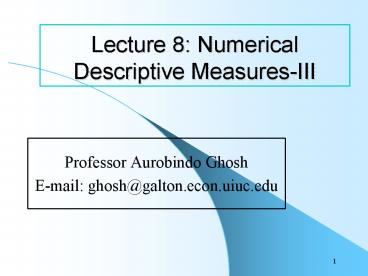Lecture 8: Numerical Descriptive MeasuresIII - PowerPoint PPT Presentation
1 / 17
Title:
Lecture 8: Numerical Descriptive MeasuresIII
Description:
at most p% of the measurements are less than that value ... NO measurements remain unchecked. In this case choose the midpoint between ... – PowerPoint PPT presentation
Number of Views:33
Avg rating:3.0/5.0
Title: Lecture 8: Numerical Descriptive MeasuresIII
1
Lecture 8 Numerical Descriptive Measures-III
- Professor Aurobindo Ghosh
- E-mail ghosh_at_galton.econ.uiuc.edu
2
Measures of Relative Standing and Box Plots
- Percentile
- The pth percentile of a set of measurements is
the value for which - at most p of the measurements are less than that
value - at most 100(1-p) of all the measurements are
greater than that value. - Example
- Suppose 600 is the 78 percentile of a GMAT
score. Then
78 of all the scores lie here
22
200
800
600
3
- Commonly used percentiles
- First (lower) decile 10th percentile
- First (lower) quartile, Q1, 25th percentile
- Second (middle)quartile,Q2, 50th percentile
- Third quartile, Q3, 75th percentile
- Ninth (upper) decile 90th percentile
- Example 4.11
- Find the quartiles of the following set of
measurements - 7, 8, 12, 17, 29, 18, 4, 27, 30, 2, 4, 10, 21, 5,
8
4
- Solution
- First sort the measurements
- 2, 4, 4, 5, 7, 8, 10, 12, 17, 18, 18, 21, 27, 29,
30
The first quartile
At most (.25)(15) 3.75 measurements should
appear below the first quartile. Check the first
3 measurements on the left hand side.
At most (.75)(15)11.25 measurements should
appear above the first quartile. Check 11
measurements on the right hand side.
If the number of measurements is even, NO
measurements remain unchecked. In this case
choose the midpoint between these two
measurements.
5
- Box Plots
- This is a pictorial display that provides the
main descriptive measures of the measurement set - L - the largest measurement
- Q3 - The upper quartile
- Q2 - The median
- Q1 - The lower quartile
- S - The smallest measurement
An adjustment to this general description of a
box plot may be needed in the presence
of outliers. See the next example.
S
Q1
Q2
Q3
L
6
- Example 4.12 - GMAT scores
- Create a box plot for the data regarding the GMAT
scores of 200 applicants (see file Xm04-12)
7
S 410
Q1 530
Q2 560
Q3 590
L 700
IQR Q3 - Q1 590 - 530 60
Fences Q1-1.5(IQR), Q31.5(IQR 440, 670
The outliers are 700, and 410.
Therefore, the whiskers will extend to the two
extreme values that are not outliers (440 and
670). Observe.
8
S 410
Q1 530
Q2 560
Q3 590
L 700
25
50
25
- Interpreting the box plot results
- The scores range from 410 to 700.
- About half the scores are smaller than 560, and
about half are larger than 560. - About half the scores lie between 530 and 590.
- About a quarter lies below 530 and a quarter
above 590.
9
S 410
Q1 530
Q2 560
Q3 590
L 700
25
50
25
The distribution is very symmetrical
50
25
25
10
Approximating Descriptive Measures for grouped
Data
- Approximating descriptive measures for grouped
data may be needed in two cases - when approximated values.suffices the needs,
- when only secondary grouped data are available.
The midpoint of class i
fimi is approx.equal to the number of
measurements in class i
The number of classes
Frequency of class i
n f1f2 fk
11
- Example 4.13
- Approximate the mean and standard deviation of
the telephone call durations problem (example ),
as represented by the frequency distribution
Class Class Frequency Midpoint
i limits fi mi fimi fimi2
1 2-5 3 3.5 10.5 36.75 2 5-8 6 6.
5 39.0 253.5 3 8-11 8 9.5 76.0 722.o . . . .
. . 6 17-20 2 18.5 37.0 684.5 n
30 312.0 3,751.5
3.5
12
Measures of Association
- Two numerical measures are presented, for the
description of linear relationship between two
variables depicted in the scatter diagram. - Covariance - is there any pattern to the way two
variables move together? - Correlation coefficient - how strong is the
linear relationship between two variables
13
The covariance
mx (my) is the population mean of the variable X
(Y) N is the population size. n is the sample
size.
14
- If the two variables move the same direction,
(both increase or both decrease), the covariance
is a large positive number.
- If the two variables move in two opposite
directions, (one increases when the other one
decreases), the covariance is a large negative
number. - If the two variables are unrelated, the
covariance will be close to zero.
15
The coefficient of correlation
- This coefficient answers the question How strong
is the association between X and Y.
16
Strong positive linear relationship
1 0 -1
COV(X,Y)gt0
or
r or r
No linear relationship
COV(X,Y)0
Strong negative linear relationship
COV(X,Y)lt0
17
- If the two variables are very strongly positively
related, the coefficient value is close to 1
(strong positive linear relationship). - If the two variables are very strongly negatively
related, the coefficient value is close to -1
(strong negative linear relationship). - No straight line relationship is indicated by a
coefficient close to zero.































